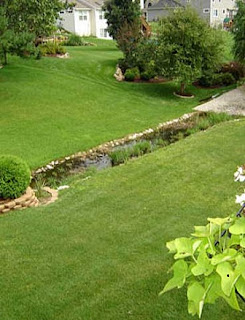Suitable Houston drainage is necessary for the health of
many plants. If the soil surrounding plants holds an excessive amount of water
or there is standing water in the area, even the most hardy tree can quickly
give way to rot. Water works to displace oxygen that is in the soil, which in
turn will suffocate the roots of plants and trees.
Houston Drainage:
Homeowners that reside in wet soils begin to believe they
have very few options when it comes to landscaping their property. Many plants
that can offer beauty and color to a yard are tolerant to wetter climates.
Landscapers who are taking on a job that is in a wet region must obtain key
data information about the areas soil and the regular precipitation. They will
also need to learn about the amount of clay and sand that make up the soil.
Once they have these answers then they will need to determine the type of
drainage that is available on the property. Homeowners must be aware of any
natural waterways that could cause flooding during heavy rainfalls. Most
counties construct maps of these types of waterways and can provide copies for
a fee. Obtaining information will help homeowners and landscapers choose the
most successful plants for their specific climate.
Two shrubs that will work for homeowners who have poor
Houston drainage are the black chokeberry and winterberry since they thrive on
moist soil. A male winterberry plant that is planted along with many female
plants will production large amounts of red berries throughout the winter. Both
of these shrubs can serve as groundcover and protection against soil erosion in
wet areas. The bushes also attract wildlife since the berries are a good food
source for birds in the winter. With the addition of a birdhouse, you will have
activity all winter.
Another option to add color to an area with damp soil is
the addition of the pussy willow, they can be trimmed to variable heights and
the flower producing catkins provide beautiful color. If you are looking for
bright blossoms, marsh marigolds provide vibrant yellow blossoms and their
compact size makes them an ideal choice for supplementing flowerbeds.
If you are wishing to add more varieties of plants in
damp soil areas then additional drainage ideas will need to be created. If
there are any dry creek beds in the area these can be used to release standing
water or slow-drain water in the event of a storm. Natural waterways on the
property can make this project easier to complete. Adding plants along the
creek bed is another way to make the creek become a beautiful landscaped focal
point. If creek beds are not an option then the addition of culverts may be
necessary. Many landscaping services can offer input on a clear option for
drainage issues.
When you are making major changes to your Houston
drainage always, pay close attention to changes in the health of the landscapes
plant life. If plants that are moderately water tolerant show signs of rot or
overall health, you will need to act quickly to prevent plant death.

No comments:
Post a Comment